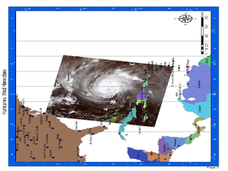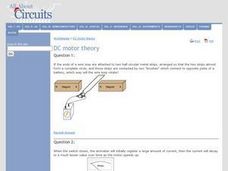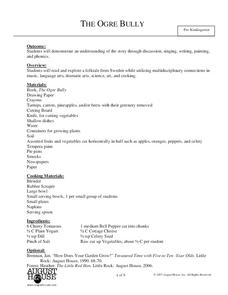Curated OER
Heat Loss and Cool Gains
Fifth graders predict what happens when cold and hot water are mixed together. In this physics lesson, 5th graders discuss how heat transfer takes place. They record temperature readings and compare it with their prediction.
Curated OER
Water Cycle in a Box
Fourth graders investigate how the water cycle is vital for all living things to survive on Earth. They observe the teacher set up a simulation of the water cycle using a Plastic Earth Simulator, desk lamp, and water, and make...
Curated OER
Weather: Piecing It All Together
Fourth graders collect, record, and analyze data using simple weather instruments and a variety of weather resources to investigate weather. They observe the teacher demonstrate how a rain gauge functions, record the weather for five...
Curated OER
Performance-based Assessments for Digital Circuit Competencies
For this electronics worksheet, students construct 43 circuits based on the schematic diagrams. They compare prediction with actual measurements.
Curated OER
Why is it so hot when I sit next to the window?
Students investigate how energy travels through glass. For this energy usage lesson, students conduct an experiment in which they decide if window film affects how much energy travels through the glass. Students use a journal to make...
Curated OER
Lights Light Up My Life
Middle schoolers conduct an investigation. For this energy conservation lesson, students observe and make predictions about fluorescent and incandescent light bulbs. Working in groups, middle schoolers conduct an investigation to...
Curated OER
Causal Patterns in Ecosystems Section 3
Students design and create a worm and worm free compost tanks for observation of decay in ecosystems. They make predictions, care, and revist tanks using their journals for observation and data collection.
Curated OER
Engineering: Which Roof Is Tops?
Students determine regional climates by examining photos of house roofs. They observe teacher-constructed examples of roofs and make predictions as to which style is best for snowy climates. After evaluating the examples, they record...
Curated OER
A Hidden Beauty
Expose the beautiful mystery of bulbs as young botanists learn all about these fascinating plants. They glean information from a short text before observing actual bulbs (consider an onion), and comparing their findings with predictions....
Curated OER
Paper Airplane Contest
Students research principles of flight. They design their own paper airplanes and make predictions about the performance of different designs. Students keep track of their findings in an electronic journal.
Curated OER
Photosynthesis Explored
Students observe the production of gas as an effect of photosynthesis. In this biology lesson, students perform an experiment with pondweed and make measurements and predictions about photosynthesis and the plant.
Curated OER
Hurricane Winds: A Spatial Hierarchy of Processes at Different Scales
In this earth science lesson, students study a satellite image of hurricane Isabel and write answers to 5 questions that follow. They match predictions to the map locations.
Curated OER
Learning About Decay Demonstrations
Students explore decay in ecosystems by investigating a rotting log and/orcreating a decomposition chamber. They make predictions and answer questions about the changes involved.
Curated OER
DC Motor Theory
In this physics worksheet, students solve 12 problems on DC motor circuit. They make predictions and construct the corresponding circuit to verify if they are correct.
Curated OER
A Science Experiment With Crayfish
A crayfish can lead to a science experiment involving habitats, animal behavior, and anatomy..
Curated OER
Scientific Method
Young scholars conduct an experiment and complete a chart demonstrating some of the basic properties and components of water via the scientific method. They encompass strategies such as questioning, making predictions,...
Curated OER
Friction
Students explore friction as a force that slows moving objects, explain conclusions in terms of the roughness or smoothness of surfaces, relate results to predictions, and begin to know how to plan a fair test.
Curated OER
The Forgotten Cities
Students recognize and identify gaps in historical and archaeological evidence and how that evidence is interpreted. They explore the history of the Indus cities and identify what was left behind that survived for archaeologists to find...
Curated OER
The Ogre Bully
Students listen to the book, The Ogre Bully, and discuss the problems the farmer and his family had during the story. In this garden themed lesson, students examine different fruit and vegetables and plant them in soil to grow. ...
Curated OER
2007 U.S. National Chemistry Olympiad Part II
Eight multi-step chemistry problems, including analyzing a titration, writing equations, predicting products and limiting reagents, calculating concentrations of ions, and using stoichiometry to solve for unknowns in reactions make up...
Curated OER
How Many Organisms Live Here?
Students observe pond organisms through a sample from a pond. In this pond organisms lesson, students use a pail and scoop from the bottom of the pond to take a sampling. Students analyze the organisms removed from the pond and predict...
Curated OER
WEATHER SATELLITE PREDICTION PROJECT
High schoolers compile weather satellite data from three satellites for one month, obtain weather reports and data from professionals, then create a document with predicted results.
Curated OER
How Do They "Whether" the Weather
Sixth graders are engaged in learning about weather systems, weather patterns and how to create a local forecast through a KCTS video called: "How Do They "Whether" the Weather?" Students actively learn how movements in atmosphere are...
Curated OER
Defining Biology
Sixth graders engage in a brainstorming activity in which they predict what the next grade level or subject matter curriculum offer. They write and draw a picture about their predictions.

























